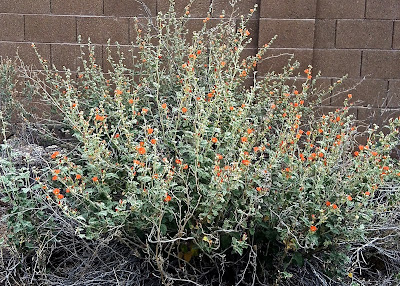With the digging completed, I planted the Three Sisters triad using seed varieties from Native Seed Search. The Yuman Yellow corn was started indoors three weeks ago, and then transplanted. They seems to be thirstier than I expected, taking time to acclimate. Just over the weekend, I planted O' Odham Vayos common beans. They popped up and put out two pairs of real leaves almost overnight, like Jack's magic beans. If they keep up this scorching pace, they might overtake and overwhelm the corn stalks! I've started Dark Star zucchini to be the third sister, under the partial shade of my living mulch.
Over the winter I let my plots go fallow to be overtaken by all the dominant herbal species that I had innocently planted: chocolate mint, "best" mint, catnip, lavender, parsley, and last but not least, a mystery plant, the dominant weed of my back yard. What makes it a dominant weed? It's just a (native or naturalized) plant growing where it's perfectly suited, but totally unwanted. This one had certainly taken over a part of the back yard, poking up through the crushed rock, proliferating everywhere there's moisture, sipping at the landscaping drip irrigation. There aren't any specimens of this plant outside the boundaries of my backyard wall. Like dandelions, it's got terrific tap roots! The above-ground part of the plant breaks off leaving the buried root to send up more greenery. It's irritating as a weed, but a garden workhorse if the roots are allowed to dig into heavy clay soil, and the foliage is allowed to shade the roots of the wanted plant, acting like a nurserymaid plant. The foliage is lacy and attractive as weeds can be. They form a continuous fluffy layer of green 10" high. I don't remember ever seeing any blossoms, but there must have been some in order to propagate so broadly, so readily.
Last year's sunflowers have also been propagating across the yard from their original flowerbed, but haven't made it to the vegetable plots yet. I'm told that sunflowers are sometimes called a Fourth Sister for their help in attracting bees to pollinate the corn. They are welcome, and even deserve being planted directly! (Note to myself - go plant some sunflowers in the corners of the plots.) In the meantime, the composite living mulch is shielding new carrots and the golden offspring of last year's marigolds, by keeping soil moisture from evaporating in the 90 deg (nearly 100 deg) Arizona temperature. Green, yellow and orange bell peppers have been planted in mini-clearings and the yellow and orange tomato varieties will go in as those seedlings develop. Has anyone ever had a pale pink Georgia Peach tomato? Come by my house in a few months and maybe you'll taste it for yourself!


.JPG)





